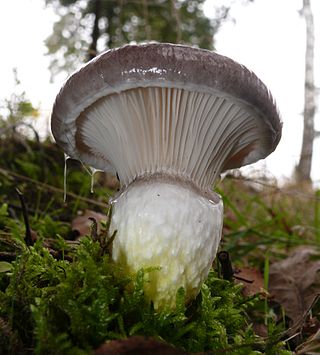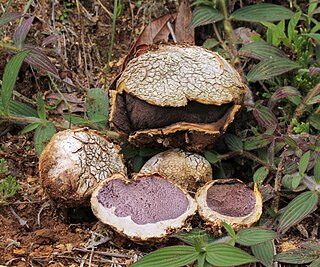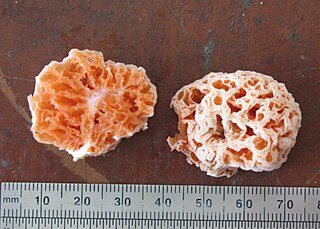
The Boletales are an order of Agaricomycetes containing over 1300 species with a diverse array of fruiting body types. The boletes are the best known members of this group, and until recently, the Boletales were thought to only contain boletes. The Boletales are now known to contain distinct groups of agarics, puffballs, and other fruiting-body types.

Strobilomyces is a genus of boletes. The only well-known European species is the type species S. strobilaceus, known in English as "old man of the woods".

Boletus is a genus of mushroom-producing fungi, comprising over 100 species. The genus Boletus was originally broadly defined and described by Carl Linnaeus in 1753, essentially containing all fungi with hymenial pores instead of gills. Since then, other genera have been defined gradually, such as Tylopilus by Petter Adolf Karsten in 1881, and old names such as Leccinum have been resurrected or redefined. Some mushrooms listed in older books as members of the genus have now been placed in separate genera. These include such as Boletus scaber, now Leccinum scabrum, Tylopilus felleus, Chalciporus piperatus and Suillus luteus. Most boletes have been found to be ectomycorrhizal fungi, which means that they form a mutualistic relationship with the roots system of certain kinds of plants. More recently, Boletus has been found to be massively polyphyletic, with only a small percentage of the over 300 species that have been assigned to Boletus actually belonging there and necessitating the description and resurrection of many more genera.

The Tricholomataceae are a large family of fungi within the order Agaricales. Originally a classic "wastebasket taxon", the family included any white-, yellow-, or pink-spored genera in the Agaricales not already classified as belonging to e.g. the Amanitaceae, Lepiotaceae, Hygrophoraceae, Pluteaceae, or Entolomataceae.

Gomphidius is a genus of mushrooms, commonly known as spike-caps, that are members of the Boletales, or pored fungi. They appear to have gill-like structures which resemble those of agarics, however the similarity is superficial only. The best-known member is the slimy spike-cap. The genus has a widespread distribution, especially in north temperate areas, and contains 10 species.

Chroogomphus is a genus of mushrooms commonly known as pine-spikes or spike-caps based on their shape and because they are often found growing in association with pine trees. The genus is distributed throughout the Northern Hemisphere including North America, the Caribbean, Europe, and Asia.

The Suillaceae are a family of fungi in the order Boletales, containing the boletus-like Suillus, the small truffle-like Truncocolumella, as well as the monotypic genus Psiloboletinus. As of 2008, there are 54 species in the family. Gastrosuillus, once considered a distinct genus, has been shown with molecular analysis to be a recent evolutionary derivative of Suillus. Fuscoboletinus, described by Pomerleau and Smith in 1962, has also been subsumed into Suillus.

Scleroderma is a genus of fungi, commonly known as earth balls, now known to belong to the Boletales order, in suborder Sclerodermatineae. The best known species are S. citrinum and S. verrucosum. They are found worldwide. Various members of this genus are used as inoculation symbionts to colonize and promote the growth of tree seedlings in nurseries. They are not edible.

Gyrodon is a genus of pored mushroom bearing close affinity to the genus Paxillus. Recent molecular research has confirmed this relationship of the two genera as sister taxa, together diverging as one of the most basal lineages in the Boletineae, and sister to the Boletaceae.

Boletellus is a genus of fungi in the family Boletaceae. The genus has a widespread distribution, especially in subtropical regions, and contains about 50 species. The genus was first described by American mycologist William Alphonso Murrill in 1909. The genus name means "small Boletus".

Chalciporus is a genus of fungi in the family Boletaceae. There are approximately 25 species in the genus.

Phylloporus is a genus of fungi in the family Boletaceae. The genus has a cosmopolitan distribution, and contains about 50 species, mostly in tropical areas.

Pisolithus is a genus of fungi within the family Sclerodermataceae.

Boletinellus is a genus of fungi in the family Boletinellaceae. The genus was first described by American mycologist William Alphonso Murrill in 1909.

Truncocolumella is a genus of fungi in the family Suillaceae, of the order Boletales. It was circumscribed by American mycologist Sanford Myron Zeller in 1939. One field guide lists the potato-like Truncocolumella citrina as edible. • To determine the odour of Truncocolumella citrina mature fruiting bodies of were extracted in diethyl ether and analyzed by gas chromatography-mass spectroscopy (GC-MS). The two major odor compounds that were identified are hexanoic acid and phenylacetaldehyde. These compounds were not found on examination of immature fruiting bodies.

Spongiforma thailandica is a species of fungus in the family Boletaceae, genus Spongiforma. The stemless sponge-like species, first described in 2009, was found in Khao Yai National Park in central Thailand, where it grows in soil in old-growth forests. The rubbery fruit body, which has a strong odor of coal-tar similar to Tricholoma sulphureum, consists of numerous internal cavities lined with spore-producing tissue. Phylogenetic analysis suggests the species is closely related to the Boletaceae genera Porphyrellus and Strobilomyces.

Spongiforma is a genus of sponge-like fungi in the family Boletaceae. Newly described in 2009, the genus contains two species: S. thailandica and S. squarepantsii. The type species S. thailandica is known only from Khao Yai National Park in central Thailand, where it grows in soil in old-growth forests dominated by dipterocarp trees. The rubbery fruit bodies, which has a strong odour of coal-tar similar to Tricholoma sulphureum, consists of numerous internal cavities lined with spore-producing tissue. S. squarepantsii, described as new to science in 2011, is found in Malaysia. It produces sponge-like, rubbery orange fruit bodies with a fruity or musky odour. These fruit bodies will—like a sponge—resume their original shape if water is squeezed out. The origin of the specific name derives from its perceived resemblance to the cartoon character SpongeBob SquarePants. Apart from differences in distribution, S. squarepantsii differs from S. thailandica in its colour, odour, and spore structure.

Aphroditeola is an agaric fungal monotypic genus that produces pink cantharelloid fruit bodies on coniferous forest floors. The lamellae are forked and typically the fruit bodies have a fragrant odor described as candy-like, cinnamon-like or pink bubble gum-like.

The Boletineae are a suborder of the fungal order Boletales. Families in the Boletineae include the Boletaceae and the Paxillaceae.

Leucogyrophana is a genus of fungi in the family Hygrophoropsidaceae. The genus was erected in 1958 to accommodate the species then known as Merulius molluscus. Several more species were described, but DNA testing in 2001 found that L. mollusca was isolated genetically from the others, and most closely related instead to Hygrophoropsis.




















